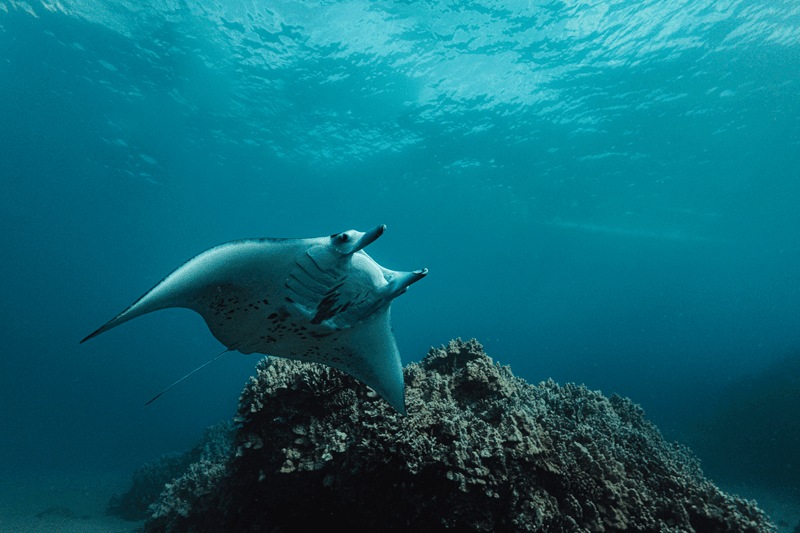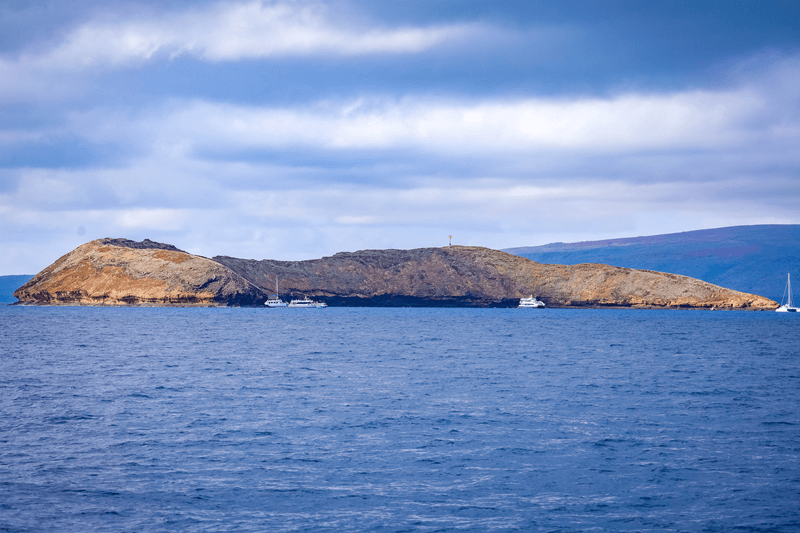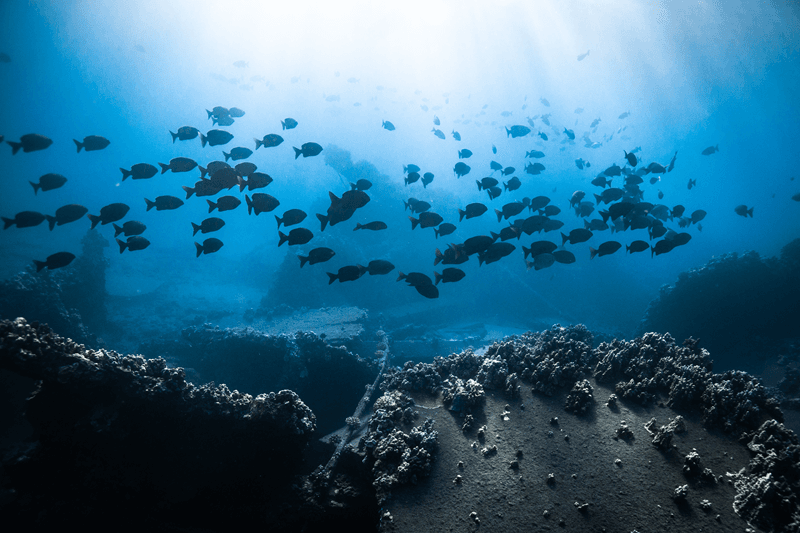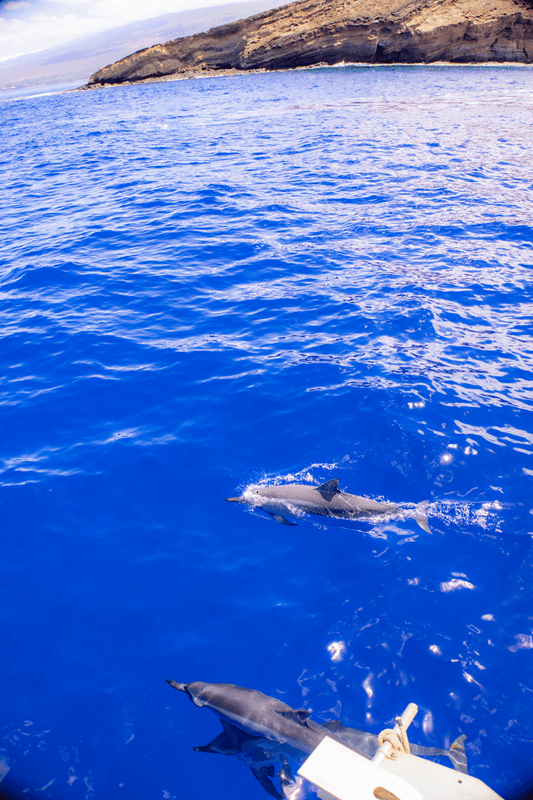Meereslebewesen auf Molokini präsentiert Hawaiis lebendigste Unterwasserwelt – kristallklares Schnorcheln mit Falterfischen, Doktorfischen und maurischen Götzenbildern in einem geschützten Krater – während Turtle Town hautnahe Begegnungen mit grünen Meeresschildkröten entlang atemberaubender Lavafingerriffe ermöglicht.
Planen Sie einen Schnorchelausflug bei Molokini-Krater oder Schildkrötenstadt? Hier ist eine kurze, erfahrungsbasierte Anleitung zum Meereslebewesen auf Molokini Sie werden wahrscheinlich (und wie oft) die beste Zeit dafür sehen und es gelten respektvolle Beobachtungsregeln, die die Tierwelt schützen.
Möchten Sie Fisch-IDs? Sehen Sie sich unsere inselweite Leitfaden zur Fischbestimmung auf Maui!
Molokini-Krater (Meeresleben auf Molokini und wann Sie es sehen werden)
Molokini ist ein Meeresschutzgebiet, das nur mit dem Boot erreichbar ist und etwa 5 Kilometer vor der Küste liegt. Im Inneren des Kraters ist das Wasser ruhig und kristallklar – perfekt für Schnorchler. Die Außenwand fällt tiefer ab und eignet sich am besten für Taucher.
Wahrscheinlich
- Gelb und Sträflings-Tangs
- Falterfisch (Waschbär, Langnase, verziert)
- Maurisches Idol
- Schwarzer Drückerfisch
- Hawaiianischer Sergeant
- Papageienfisch
Gelegentlich
Selten für Schnorchler (häufiger für Taucher)
Beste Zeit: Die Morgen sind normalerweise ruhiger und klarer.
Tipp: Bleiben Sie bei Ihrer Gruppe; die Strömungen im Randbereich können in der Nähe der Landzungen zunehmen.
Mehr erfahren / buchen: Schnorcheln im Molokini-Krater
Schildkrötenstadt (Mākena / Maluaka)
Entlang der Küste von Mākena und Maluaka bilden Lavafinger und Korallengärten eines der besten Schnorchelgebiete Mauis. Bekannt als Turtle Town, ist es berühmt für seine häufigen Sichtungen von Honu (Grünen Meeresschildkröten). Man kann es per Boot oder bei ruhigem Wetter auch vom Ufer aus erreichen.
Wahrscheinlich
Gelegentlich
Selten
- Hawaiianische Mönchsrobbe (ruhend)
Beste Zeit: Morgens: Vor dem Einlaufen Dünung/Wellengang prüfen.
Tipp: Geben Sie den Schildkröten Platz zum Auftauchen und Atmen.
Mehr erfahren / buchen: Turtle Town Tour
Meerestiere im Rampenlicht (Molokini & Turtle Town)
Grüne Meeresschildkröte (Honu)
Schildkrötenstadt: Wahrscheinlich · Molokini: Gelegentlich
Sanfte Grasfresser, die die Riffränder absuchen und alle paar Minuten zum Luftholen auftauchen. In Turtle Town können Sie Schildkröten beobachten, die über Lavafinger und Sandflächen gleiten; in Molokini werden sie gelegentlich im Krater gesichtet. Geben Sie den Schildkröten Raum –Halten Sie im Wasser und an Land mindestens 3 m Abstand.
Gefleckter Adlerrochen
Molokini: Gelegentlich · Schildkrötenstadt: Gelegentlich
Anmutige “Unterwasservögel” mit langem Schwanz und weißen Flecken. Sie mögen klares Wasser in der Nähe von Riffen und sandigen Abhängen. Gleiten Sie parallel – jagen Sie niemals – und genießen Sie einen kurzen Vorbeiflug, wenn sie am Riff vorbeifliegen.
Weißspitzen-Riffhai
Molokini: Selten für Schnorchler
Ein nachtaktiver Riffhai, der tagsüber oft am Meeresboden ruht. Taucher sehen ihn häufiger an den tieferen Rändern von Molokini; Schnorchelsichtungen sind selten, aber unvergesslich. Beobachten Sie ihn ruhig und halten Sie ausreichend Abstand.
Hawaiianischer Tageskrake (Heʻe Mauli)
Beide Standorte: Gelegentlich
Meister der Tarnung, die tagsüber jagen – besonders am frühen Morgen und am späten Nachmittag. Achten Sie auf schnelle Farb- und Texturwechsel, wenn sie sich zwischen Korallenköpfen bewegen.
Muräne
Beide Standorte: Gelegentlich
Scheue Raubtiere, die aus Felsspalten lauern; ihr geöffnetes und geschlossenes Maul dient zum Atmen. Greifen Sie niemals in Löcher oder unter Felsvorsprünge – beobachten Sie sie aus der Ferne.
Maurisches Idol
Molokini: Wahrscheinlich · Schildkrötenstadt: Wahrscheinlich
Ikonischer schwarz-weiß-gelber Fisch mit einer nachlaufenden Rückenschnur. Bewacht Riffränder und Korallenköpfe – häufig bei ruhigen Morgenbedingungen.
Gelber Doktorfisch
Beide Standorte: Wahrscheinlich
Algenfressende Doktorfische, die flache Riffe erhellen. Beobachten Sie, wie kleine Gruppen an sonnigen Hängen und in Korallengärten Algen “mähen”.
Spinnerdelfine und Buckelwale (vom Boot aus)
Transitsichtungen
Spinnerdelfine gelegentlich in der Nähe von Booten vorbeikommen – gemäß Bundesgesetz nicht mitschwimmen oder sich nähern 50 Meter. Buckelwale besuchen Sie saisonal; halten Sie eine 100-Yard-Distanz auf dem See- oder Landweg.
Echte Karettschildkröte (Honuʻea) – Selten
Echte Karettschildkröten sind in Hawaii viel seltener als Grüne Meeresschildkröten (etwa 100 zu 1 weniger) und ernähren sich von Schwämmen entlang gesunder Riffe. Wenn Sie das Glück haben, eine zu sehen, genießen Sie sie in Ruhe aus der Ferne.; Echte Karettschildkröten sind gefährdet und nur etwa 20–25 Weibchen nisten jedes Jahr auf Hawaii.
Wann Sie mehr sehen (Jahreszeit und Tageszeit)
An beiden Standorten weht morgens normalerweise weniger Wind und das Wasser ist klarer. Deshalb startet unser Ausflug nach Molokini früh – Sie schnorcheln am ruhigen inneren Rand, bevor sich der Passatwind verstärkt.
Walsaison: Buckelwale sind in Hawaii in der Regel von November bis April anzutreffen, mit einem Höhepunkt zwischen Januar und März. Sichtungen sind vom Boot aus während der Fahrt möglich – halten Sie 90 Meter Abstand zu den Walen und genießen Sie das Schauspiel.
Delfine: Gelegentlich sehen wir Spinnerdelfine vom Boot aus. Es ist verboten, mit ihnen zu schwimmen oder sich ihnen auf weniger als 45 Meter zu nähern.
Benötigen Sie Hilfe bei der Auswahl der Tageszeit? Sehen Sie sich unseren vollständigen Schnorchelführer zum Thema Morgen- und Nachmittagsschnorcheln an.
Warum Molokini so geschützt ist
Molokini Shoal ist ein Meeresschutzgebiet, das nur mit dem Boot erreichbar ist, etwa drei Meilen vor der Küste und gilt als Molokini MLCD (Meereslebensschutzgebiet) durch die Hawaii DLNR. Zum Schutz der Korallen und Meereslebensräume sind Fischen, Sammeln und Ankern verboten.
Kommerzielle Boote müssen Tagesliegeplätze (HAR 13-257) anstatt Anker zu werfen, und die Landung auf der Insel Molokini ist verboten, weil sie Teil der Staatliches Seevogelschutzgebiet von Hawaii.
Besucher können das Riff-Ökosystem des Kraters nur vom Wasser aus erleben – niemals an Land.
Verantwortungsvolle Tierbeobachtung (Kurzregeln)
🐢 Meeresschildkröten: Halten Sie mindestens 3 m Abstand– an Land und im Wasser.
🐬 Spinnerdelfine: Es ist verboten, mit ihnen zu schwimmen, sich ihnen zu nähern oder sich in einem Umkreis von 50 Metern aufzuhalten.
🐋 Buckelwale: Halten Sie mindestens 100 Meter Abstand mit allen Mitteln.
🦭 Hawaiianische Mönchsrobben: bleib mindestens 50 Fuß entfernt (150 Fuß für Mütter mit Welpen).
🌞 Sonnenschutz: Wählen Sie Mineralformeln; Hawaii verbietet den Verkauf von Sonnenschutzmitteln mit Oxybenzon und Octinoxat. (Gesetz 104 (2018).
FAQs
Gibt es Haie auf Molokini?
Ja – Weißspitzen-Riffhaie leben rund um Molokini. Schnorchelsichtungen sind selten (Taucher sehen sie häufiger an tieferen Stellen wie dem äußeren Rand/der Rückwand). Sie sind im Allgemeinen nicht aggressiv, wenn man sie respektvoll beobachtet.
Werde ich Strahlen sehen?
Gefleckte Adlerrochen tauchen gelegentlich an beiden Standorten auf. Mantas und Walhaie sind seltene Leckerbissen. Betrachten Sie jede Rochenbegegnung als Bonus.
Kann ich auf Molokini landen oder wandern?
Nein. Die Insel Molokini ist ein staatliches Seevogelschutzgebiet und das Anlegen ist verboten. Wir schnorcheln von Anlegestellen im Krater aus.
Ist Turtle Town ein einzelner, exakter Ort?
“Turtle Town” beschreibt die Lavafinger und Korallengärten der Küste von Mākena/Maluaka. Die Bedingungen und das Verhalten der Schildkröten ändern sich, daher wählen die Kapitäne an dem jeweiligen Tag das ruhigste und klarste Gebiet aus.
Welcher Sonnenschutz ist erlaubt?
Im Maui County dürfen nur mineralische Sonnenschutzmittel (Zinkoxid oder Titandioxid) ohne Rezept verkauft, verteilt oder verwendet werden. Hawaii verbietet außerdem landesweit den Verkauf von Oxybenzon und Octinoxat.
Warum gehen wir morgens?
Bei Ausflügen am Morgen ist der Wind in der Regel ruhiger und die Sicht auf Molokini und Turtle Town ist am besten – besser für die Tierbeobachtung, zum Fotografieren und für den Komfort auf dem Wasser.
Möchten Sie den Fisch identifizieren, den Sie gesehen haben? Entdecken Sie unsere Fischidentifizierung auf Maui (Fotos und Tipps)
Abschluss
Jeder Ausflug unter Mauis Wellen erzählt eine Geschichte. Ob Sie das ruhige, klare Wasser während unserer Schnorcheltour auf Molokini erkunden oder neben Meeresschildkröten in Turtle Town schwimmen, Sie werden eine Welt voller Farben und Bewegung entdecken. Von leuchtenden Falterfischen und neugierigen Papageienfischen bis hin zu sanften Honu, die über das Riff gleiten – jede Begegnung erinnert Sie daran, warum die Hawaii-Inseln so besonders sind.
Bewegen Sie sich langsam, respektieren Sie die Tierwelt und tragen Sie riffsichere Sonnencreme auf, um dieses Unterwasserparadies zu schützen. Nehmen Sie noch heute an einer Schnorcheltour auf Maui teil und erleben Sie die Magie von Meereslebewesen auf Molokini und Turtle Town selbst – zwei der unvergesslichsten Schnorchelplätze auf Hawaii!





